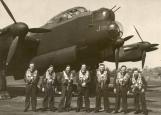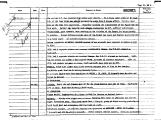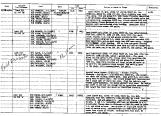1
Stewart Black- World War Two VeteranInterviewed on November 25, 2003
Stewart Black was born and raised in the community of Innisfail, on a farm east of town. His father died when he was still quite young, and his mother moved the family to town. Stewart joined the military in part because he was at loose ends; there was nothing tying him down from going to war. Also, in high school, it seemed all the boys were enlisting. Stewart joined the air cadets while he was still in school, and was later convinced to enlist in the Royal Canadian Air Force (RCAF); he joined at the young age of seventeen.
Stewart did a lot of travelling while he was receiving his training. He received his basic training with foot soldiers in Edmonton, then left for Fort McLeod to undertake his air/tarmac training. From there, Stewart spent six weeks in Regina, doing initial training, school work, learning Morris Code and air craft skills. He then spent two months in Fort William (now called Thunder Bay) where he learned to fly Tiger Moth planes. After that, he spent three months in Brandon, Manitoba learning to fly twin engine Cessnas; following that stint, Stewart received his air wings and went overseas. While overseas, Stewart received further training and converted to a four engine Lancaster Bomber. He was stationed with the 12th squadron of the RAF at Wickenby near Lincoln in England. After Stewart finished his training, he became the pilot of a crew, which contained three Canadians and four RAF (Royal Air Force) men. Stewart's crew did night flying, which meant Stewart had to complete over one month of instrument flying training, since pilots had to learn to trust their instruments if they were flying at night. Stewart was the youngest pilot in his squadron.
4
Stewart flew 31 missions and had the same crew for 30; his plane was only shot up significantly once. Stewart formed strong bonds with his crew that are still intact today. On leave, the entire crew often visited the navigator's mother in Devonshire.Stewart's crew was involved in the bombings of Ruhr Valley, Berlin, Danzig, the Polish Corridor, Hamburg, and Dusseldorf. Stewart and his team were largely responsible for distracting fighter planes; occasionally the fighters gave them a bad time. A plane was really in trouble if it got caught in a searchlight: they were blinding. Stewart was awarded the Distinguished Flying Cross for his piloting.
There were other men from Innisfail who joined alongside Stewart: William Rawlings was on the same ship as Stewart on the way overseas; Gilbert Scott came on Stewart's squadron for training; and Jack Ross, who went to school with Stewart, met him in London once. Stewart also had a brother, Richard (Dick), who joined the air force and was unfortunately shot down over Dusseldorf.
When he was on his way home, each officer was assigned five war brides on the ship to take care of. On the first night of the journey, there was a submarine scare, but after that the trip was fairly calm. When Stewart returned to Innisfail on leave after two years overseas, it was pretty quiet at home. He came home for his 21st birthday, and was on leave when the war ended.
6
This is a photograph of Stewart Black and his crew.Back row (l to r): Pete Bailey, Mid Upper Gun., RAF; Stewart Black, Pilot, RCAF; Ron Goddard, Wireless Operator, RAF; Gerry Carruthers, Bomb Ad., RCAF
Front row (l to r): Roy Holder, Navigator, RCAF; Dick Woodruff, Rear Gunner, RAF; Jim Norris, Engineer, RAF
MacDonald replaced mid upper gunner; no picture available.







